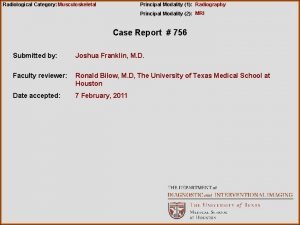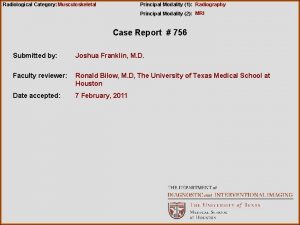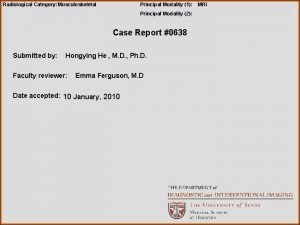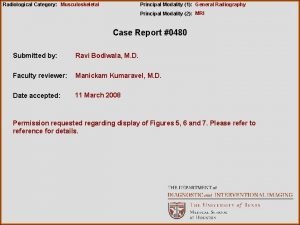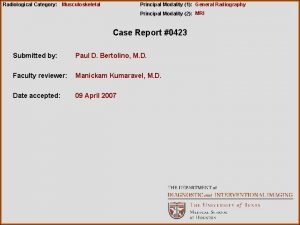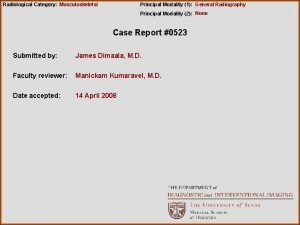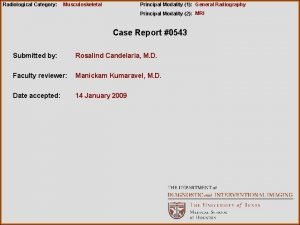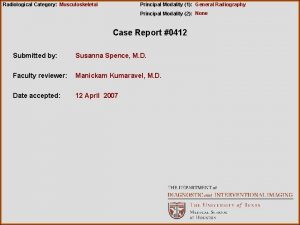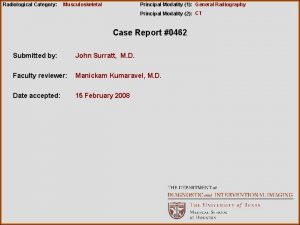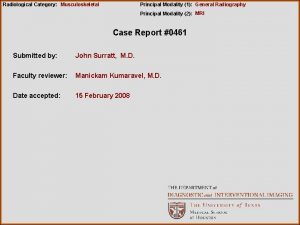Radiological Category Musculoskeletal Principal Modality 1 General Radiography











- Slides: 11

Radiological Category: Musculoskeletal Principal Modality (1): General Radiography Principal Modality (2): None Case Report #0353 Submitted by: Eric Longo, M. D. Faculty reviewer: Ronald Bilow, M. D. Date accepted: 07 December 2006

Case History 26 year-old African American male with past medical history significant for ventricular septal defect repair and renal failure at the age of eight years secondary to glomerulonephritis due to a streptococcal infection. The patient underwent renal transplantation at age 16 years. The patient later sustained rejection of the transplanted kidney and has required dialysis for end-stage renal disease. Currently, the patient complains of four months of pain, increasing enlargement and decreasing range of motion in bilateral shoulders as well as the left hip. Laboratory analysis shows normal serum calcium and phosphate levels.

Radiological Presentations

Radiological Presentations

Radiological Presentations

Test Your Diagnosis Which one of the following is your choice for the appropriate diagnosis? After your selection, go to next page. • Secondary Calcinosis of Chronic Renal Failure • Calcific Myonecrosis • Tophaceous Gout • Calcinosis Universalis • Familial or Primary Tumoral Calcinosis

Findings and Differentials Findings: Massive periarticular masses involving the shoulders and left hip with welldemarcated, dense, cloud-like and amorphous, lobulated calcification separated by areas of radiolucency situated along the extensor surfaces of the joints. Fluid levels can be seen layering within the soft tissue mass of the left shoulder. No bony erosions are present. Differentials: • Secondary Calcinosis of Chronic Renal Failure • Calcific Myonecrosis • Tophaceous Gout • Calcinosis Universalis • Familial or Primary Tumoral Calcinosis

Discussion Tumoral calcinosis is a term that has loosely been applied to describe any massive periarticular or soft tissue deposition of calcium. Tumoral calcinosis is subdivided into primary and secondary causes. Primary tumoral calcinosis refers to a hereditary defect most commonly seen in individuals of African descent. Lesions may be solitary or multiple and most commonly involve large joints like the hip, elbow, and shoulder. The lesions progress primarily during the first two decades of life. Radiographically, calcifications are dense, cystic, amorphous and lobular appearing with characteristic distribution along extensor surfaces. Fluid-fluid levels have been given the term “sedimentation sign”. The appearance may denote the metabolic activity with more homogeneous lesions being less active than more cystic appearing lesions. Osseous erosions are absent. Multiple additional findings coexist with primary tumoral calcinosis and include: dental abnormalities, ocular involvement, hyperostosis, periosteal reaction and pseudoxanthoma elasticum. Cerebral and peripheral aneurysms have even been described. Clinically, patients have painless mass-like enlargement of the joints. Patients may have decreased range of motion of the affected limb and the lesions can drain externally to the skin surface. On gross inspection, material is white to pale yellow and chalky appearing. The material consists of calcium hydroxyapatite crystals, calcium phosphate and calcium carbonate.

Discussion Laboratory analysis should reveal normal calcium, elevated phosphate, and elevated 1, 25 -dihydroxy-vitamin D levels. Clinical history and laboratory analysis are the only methods for differentiating primary tumoral calcinosis from secondary cause due to chronic renal failure. Radiographically, the two are identical. Calcific myonecrosis refers to the presence of peripheral calcification within muscle, most commonly seen in the anterior compartment of the lower extremity due to ischemia related to compartment syndrome. Clinical history, intramuscular location, and lack of mass effect are distinguishing features. Tophaceous gout is the result of years, if not decades of hyperuricemia and is often associated with underlying bony erosions. Sampling of the lesion will reveal urate crystals which generally are not radiopaque until they become secondarily calcified. Calcinosis universalis occurs in patients with connective tissue diseases, primarily polymyositis and dermatomyositis. Sheet-like calcification is present within the muscles, subcutaneous tissues, and fascial planes. Other causes of periarticular and soft tissue calcification include neoplasms such as synovial sarcoma, chondrosarcoma, osteosarcoma, myositis ossificans, synovial osteochondromatosis, Milk Alkali Syndrome, hypervitaminosis D, and sarcoidosis.

Discussion Reference: Olsen KM, Chew FS. Tumoral Calcinosis: Pearls, Polemics, and Alternative Possibilities. Radiographics 2006; 26: 871 -885.

Diagnosis Secondary Calcinosis of Chronic Renal Failure
 Erate category 2 eligible equipment
Erate category 2 eligible equipment National radiological emergency preparedness conference
National radiological emergency preparedness conference Radiological dispersal device
Radiological dispersal device Tennessee division of radiological health
Tennessee division of radiological health Center for devices and radiological health
Center for devices and radiological health Sensory vs somatic
Sensory vs somatic Epistemic modality
Epistemic modality Sodality vs modality
Sodality vs modality One to many relationship line
One to many relationship line Cardinality and modality
Cardinality and modality Cardinality and modality
Cardinality and modality Tom arbuthnot
Tom arbuthnot












